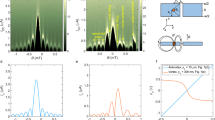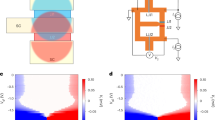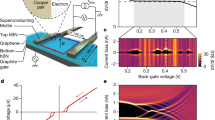Abstract
Superconducting correlations may propagate between two superconductors separated by a tiny insulating or metallic barrier, allowing a dissipationless electric current to flow1,2. In the presence of a magnetic field, the maximum supercurrent oscillates3 and each oscillation corresponding to the entry of one Josephson vortex into the barrier4. Josephson vortices are conceptual blocks of advanced quantum devices such as coherent terahertz generators5 or qubits for quantum computing6, in which on-demand generation and control is crucial. Here, we map superconducting correlations inside proximity Josephson junctions7 using scanning tunnelling microscopy. Unexpectedly, we find that such Josephson vortices have real cores, in which the proximity gap is locally suppressed and the normal state recovered. By following the Josephson vortex formation and evolution we demonstrate that they originate from quantum interference of Andreev quasiparticles8, and that the phase portraits of the two superconducting quantum condensates at edges of the junction decide their generation, shape, spatial extent and arrangement. Our observation opens a pathway towards the generation and control of Josephson vortices by applying supercurrents through the superconducting leads of the junctions, that is, by purely electrical means without any need for a magnetic field, which is a crucial step towards high-density on-chip integration of superconducting quantum devices.
This is a preview of subscription content, access via your institution
Access options
Subscribe to this journal
Receive 12 print issues and online access
$259.00 per year
only $21.58 per issue
Buy this article
- Purchase on SpringerLink
- Instant access to full article PDF
Prices may be subject to local taxes which are calculated during checkout




Similar content being viewed by others
References
De Gennes, P. G. Boundary effects in superconductors. Rev. Mod. Phys. 36, 225–237 (1964).
Josephson, B. D. Possible new effects in superconductive tunnelling. Phys. Lett. 1, 251–253 (1962).
Rowell, J. M. Magnetic field dependence of the Josephson tunnel current. Phys. Rev. Lett. 11, 200–202 (1963).
Tinkham, M. Introduction to Superconductivity (McGraw Hill, 1996).
Ulrich Welp, U., Kadowaki, K. & Kleiner, R. Superconducting emitters of THz radiation. Nature Photon. 7, 702–710 (2013).
Devoret, M. & Schoelkopf, R. Superconducting circuits for quantum information: An outlook. Science 339, 1169–1174 (2013).
Cuevas, J. C. & Bergeret, F. S. Magnetic interference patterns and vortices in diffusive SNS junctions. Phys. Rev. Lett. 99, 217002 (2007).
Andreev, A. F. Electron spectrum of the intermediate state of superconductors. Zh. Eksp. Teor. Fiz. 49, 655–660 (1965); Sov. Phys. JETP 22, 455–458 (1966)
Barone, A. & Paterno, G. Physics and Applications of the Josephson Effect (Wiley, 1982).
Heersche, H. B., Jarrillo-Herrero, P., Oostinga, O. O., Vandersypen, L. M. K. & Morpurgo, A. F. Bipolar supercurrent in graphene. Nature 446, 56–59 (2007).
Veldhorst, M. et al. Josephson supercurrent through a topological insulator surface state. Nature Mater. 11, 417–421 (2012).
Williams, J. R. et al. Unconventional Josephson effect in hybrid superconductor–topological insulator devices. Phys. Rev. Lett. 109, 056803 (2012).
Abrikosov, A. A. On the magnetic properties of superconductors of the second group. Sov. Phys. JETP 5, 1174–1182 (1957).
Maggio-Aprile, I. et al. Critical currents approaching the depairing limit at a twin boundary in YBa2Cu3O7−δ . Nature 390, 487–490 (1997).
Song, C-L. et al. Suppression of superconductivity by twin boundaries in FeSe. Phys. Rev. Lett. 109, 137004 (2012).
Brun, C. et al. Remarkable effects of disorder on superconductivity of single atomic layers of lead on silicon. Nature Phys. 10, 444–450 (2014).
Tsuei, C. C. & Kirtley, J. R. Pairing symmetry in cuprate superconductors. Rev. Mod. Phys. 72, 969–1016 (2000).
Blatter, G. & Geshkenbein, V. B. The Physics of Superconductors Vol. 1 (eds Bennemannand, K. H. & Kettersonet, J. B.) Ch. 10, 896–897 (Springer-Verlag, 2003)
Gurevich, A. Nonlocal Josephson electrodynamics and pinning in superconductors. Phys. Rev. B 46, 3187(R) (1992).
Kogan, V. G. et al. Josephson junction in a thin film. Phys. Rev. B 63, 144501 (2001).
Hess, H. F., Robinson, R. B., Dynes, R. C., Valles, J. M. & Waszczak, J. V. Scanning-tunneling-microscope observation of the Abrikosov flux lattice and the density of states near and inside a fluxoid. Phys. Rev. Lett. 62, 214–216 (1989).
Zhang, T. et al. Superconductivity in one-atomic-layer metal films grown on Si(111). Nature Phys. 6, 104–108 (2010).
Serrier-Garcia, L. et al. Scanning tunneling spectroscopy study of the proximity effect in a disordered two-dimensional metal. Phys. Rev. Lett. 110, 157003 (2013).
Eom, D., Qin, S., Chou, M-Y. & Shih, C. K. Persistent superconductivity in ultrathin Pb films: A scanning tunneling spectroscopy study. Phys. Rev. Lett. 96, 027005 (2006).
Nishio, T. et al. Superconducting Pb island nanostructures studied by scanning tunneling microscopy and spectroscopy. Phys. Rev. Lett. 101, 167001 (2008).
Cren, T., Fokin, D., Debontridder, F., Dubost, F. & Roditchev, D. Ultimate vortex confinement studied by scanning tunneling spectroscopy. Phys. Rev. Lett. 102, 127005 (2009).
Brun, C. et al. Reduction of the superconducting gap of ultrathin Pb islands grown on Si(111). Phys. Rev. Lett. 102, 207002 (2009).
Cren, T., Serrier-Garcia, L., Debontridder, F. & Roditchev, D. Vortex fusion and giant vortex states in confined superconducting condensates. Phys. Rev. Lett. 107, 097202 (2011).
Altshuler, B. L. & Aronov, A. G. in Electron–Electron Interactions in Disordered Systems (eds Efros, A. L. & Pollak, M.) (Elsevier Science Publisher B. V., 1985).
Golubov, A. A. & Kupriyanov, M. Y. Theoretical investigation of Josephson tunnel junctions with spatially inhomogeneous superconducting electrodes. J. Low Temp. Phys. 70, 83–130 (1988).
Belzig, W. et al. Local density of states in a dirty normal metal connected to a superconductor. Phys. Rev. B 54, 9443–9448 (1996).
Kim, J. et al. Visualization of geometric influences on proximity effects in heterogeneous superconductor thin films. Nature Phys. 8, 464–469 (2012).
Le Sueur, H., Joyez, P., Pothier, H., Urbina, C. & Esteve, D. Phase controlled superconducting proximity effect probed by tunneling spectroscopy. Phys. Rev. Lett. 100, 197002 (2008).
Usadel, K. D. Generalized diffusion equation for superconducting alloys. Phys. Rev. Lett. 25, 507–509 (1970).
Acknowledgements
T.C., C.B., F.D., V.S. and D.R. acknowledge financial support from the French ANR project ELECTROVORTEX and the French-Russian program PICS-CNRS/RAS. The authors also thank V. Cherkez for assistance during experiments and V. Vinokur (Argonne National Laboratory, Illinois USA) and A. Buzdin (University of Bordeaux 1, France) for stimulating discussions. J.C.C. acknowledges financial support from the Spanish MICINN (Contract No. FIS2011-28851-C1). V.H.L.B. acknowledges support from CNPq Brazil and productive discussions with Prof. A. Chaves (UFC, Brazil). M.V.M. acknowledges support from Research Foundation Flanders (FWO-Vlaanderen) and CAPES Brazil (PVE project BEX1392/11-5).
Author information
Authors and Affiliations
Contributions
The experiments were conceived by D.R., T.C., C.B. and F.D. The experiments were performed by C.B., D.R., L.S-G., T.C., V.S. and F.D. Theoretical support was provided by J.C.C., V.H.L.B. and M.V.M. Superconducting correlation maps were calculated by T.C. The manuscript was written by D.R., J.C.C. and T.C. with comments and input from all authors.
Corresponding author
Ethics declarations
Competing interests
The authors declare no competing financial interests.
Supplementary information
Supplementary Information
Supplementary Information (PDF 2247 kb)
Rights and permissions
About this article
Cite this article
Roditchev, D., Brun, C., Serrier-Garcia, L. et al. Direct observation of Josephson vortex cores. Nature Phys 11, 332–337 (2015). https://doi.org/10.1038/nphys3240
Received:
Accepted:
Published:
Issue date:
DOI: https://doi.org/10.1038/nphys3240
This article is cited by
-
Electronic Structure of Pinned Abrikosov Vortices: Andreev Theory of Quasiparticle Bound States
Journal of Low Temperature Physics (2024)
-
Interference, diffraction, and diode effects in superconducting array based on bismuth antimony telluride topological insulator
Communications Physics (2023)
-
Tuning lower dimensional superconductivity with hybridization at a superconducting-semiconducting interface
Nature Communications (2022)
-
The morphologic correlation between vortex transformation and upper critical field line in opal-based nanocomposites
Scientific Reports (2021)
-
Modulated Time Delays, Synchronized Josephson Junctions in High-Temperature Superconductors and Chaotic Terahertz Waves
Journal of Superconductivity and Novel Magnetism (2021)



